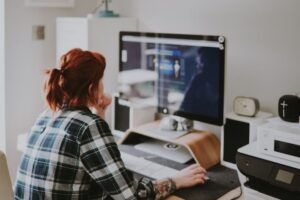
We are a reader-supported education publication. When you buy through links on our site, we may earn an affiliate commission to help us keep providing content.
A recent spike in mental health awareness drove scientists to evaluate various therapeutic approaches. Although conventional therapy is effective, it is not a one size fits all model. Psychologists developed animal-assisted, sand play, music, and art therapy for patients who feel uncomfortable in a traditional office setting.
Art therapy allows one to express mental struggles through artistic mediums. When they reveal distress through drawing, painting, sculpting, and more, a therapist can address the issue and offer coping tools. This form of therapy proves effective for all ages and mental struggles.
The Importance of Art Therapy
Alternative forms of therapy are essential to validate and support all patients. Therapists combine free art expression and talk therapy. They have their patients develop images and look within to find meaning and evaluate personal struggles. Art therapy can work to support various illnesses, like:
- stress and depression in cancer patients.
- mental distress in dementia patients.
- anxiety and stress in asthmatic children.
- general depression and anxiety.
- trauma.
- eating disorders.
The list goes on. For patients who fear speaking or have trouble expressing themselves, art therapy may provide an effective solution. If you are ready to become an art therapist, you may start by evaluating your organic skill set and interests.
Skills and Interests
Specific talents help students succeed in an art therapy master’s program. You should enjoy engaging in interpersonal communication, as this consumes much of the job. One may also have a strong interest in human development and psychology.
These skills support a therapist’s ability to diagnose a patient and engage in supportive feedback. In addition to the traditional therapeutic values, potential students should have a strong interest in the field of creative art. Practicing some form of expressive art indicates that art therapy may be the profession for you.
If you are an undergraduate student thinking about studying art therapy, it is better to start your education now. Many colleges offer a five-year accelerated program for students working towards their masters in this field of study. Enrolling in this program as an undergraduate will help you reach your career goals faster than the traditional education track.
Explore Masters Programs
Once you have decided that you want to become an art therapist, you need to explore and apply to art therapy master’s programs. All regions of the U.S. have art therapy programs, allowing educational access to all Americans.
These programs offer a comprehensive curriculum, which provides students a range of experimental learning and hands-on opportunities to help them succeed in their careers as therapists. They are 60 credit programs that typically take two to three years of full-time study.
When you are ready to explore master’s programs, evaluate your regional options. To further prepare for your time in higher education, you may want to assess the coursework associated with these programs.
Coursework
Once accepted into an art therapy school, you will complete a wide variety of classes and activities to receive your degree. The courses consist of a mix of psychology and art lectures. You will study the psychology of consciousness, theories of counseling, art therapy techniques, and more.
During your time in school, you will also participate in practicums and internships. In these experiences, you will put your classroom knowledge to use in the field. These hands-on activities will be preparing you for your future career. Finally, you will end your program by completing a capstone.
Self-Care
This course load may seem overwhelming at times, reflecting the harsh material you will face in the field. Both in school and the profession, participants may feel mentally and emotionally drained. Therapists and students view unsettling content that may leave them feeling upset, uneasy, and anxious.
To challenge these emotions and continue performing sufficient work, students may practice self-care. Catering to your mental health is vital to supporting yourself through hard times. You can engage in journaling, meditating, walking, regular sleep and exercise, hobbies, taking baths, yoga, and supportive social interactions.
Understanding the Lifestyle
To become a successful art therapist, it is beneficial to prepare for the career’s lifestyle. Most professionals in the industry work full time, 30 to 40 hour work weeks. They also work in a variety of settings.
As an art therapist, you may work in a hospital, inpatient or outpatient facility, school, research center, correctional facility, shelter, crisis center, senior center, and more. You will also receive a salary between $37,573 and $47,402 a year. Your salary will depend on where you live and whether you work for a company or your own practice.
Further Steps
When working to become an art therapist, reach out to local individuals in the profession and consult them about their process. You may then evaluate your higher learning options based on your current level of education. When following your path towards becoming an art therapist, remember to take care of yourself throughout the journey.
Looking to learn more about art therapy? Check out these top picks from our reading list:
Essential Art Therapy Exercises: Effective Techniques to Manage Anxiety, Depression, and PTSD (Amazon) by Leah Guzman, ATR-BC
Approaches to Art Therapy: Theory and Technique (Amazon) by Judith Aron Rubin
Nature-Based Expressive Arts Therapy (Amazon) by Sally Atkins
latest in learning!
Get the latest updates in learning, teaching and everything in between! Whether you're a student or an educator, we offer the inspiration you need to fuel your classroom experience.









